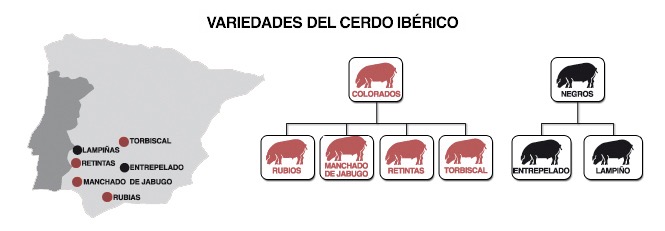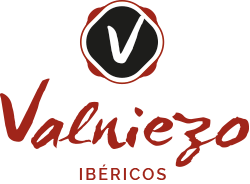
The breed
The Black Iberian Pig has very ancient origins. It derives from the interbreeding of a pig breed introduced to the Iberian Peninsula by the Phoenicians with the native wild boar. Various breeds resulted from this, and the so-called Colorada (“Coloured”) and Negra (“Black”) are the two main ones surviving today. Furthermore, each area where Ibérico pork is produced has its own variant of a breed: Rubio, Manchade de Jabugo, Retinta, and Trobiscal are descendant from the Colorada, and Entrepelada and Lampiña from the Negra.
The denomination Pata Negra developed because originally the most common breeds were the Entrepelada and the Lampiña, both of which have distinctive black hoofs. Today, however, the term Pata Negra is used more generically for any ham made from 100% purebred Ibérico pork, regardless of whether it is derived from the Negra or Colorada breeds.
Each geographical area has its own variant of the breed, and each of these has its own specific characteristics, even if these are barely perceptible in the final product.
However, there are quite obvious differences between a ham produced from 100% purebred Ibérico pork (of whichever variant of the breed) and a ham produced with crossbred Ibérico pork, not only in the shape and bone structure of the leg, but also from an organoleptic point of view.
In order to be able to classify an Iberian ham (Jamón Ibérico) of excellent quality it needs to be made from an animal of pure (100%) Ibérico pork, or, alternatively, from a cross-breed of at least 75% Ibérico with some Duroc-Jersey meat.
In the first case, the ham is called 100% bellota ibérico ham, while in the second case it is bellota ibérico ham.

The animal
The physical appearance of the Iberian Pig differentiates itself very clearly from that of other breeds, because it is much more long-limbed, owing also to the fact that it is raised free-range.
The head is small in proportion to the rest of the body, the snout is big, the neck short and very muscular, and the hoof open and black. The animals have little fur, their skin is dark and sometimes features light, white, beige, or brown, marks, while the legs are long, thin and muscular, enabling them to cover great distances on the hunt for food.
Owing to its peculiar genetic characteristics, the Ibérico Pig is the only pig breed in the world that can store great amounts of adipose tissue which then seeps into the muscle tissue, lending its meat a distinctive aspect and incomparable oiliness, texture, and aroma.
Diet and habitat are the reasons for its singularity.
The production of a jamón puro de bellota is a very long and costly process. This, together with its exceptional flavour, make it a very exclusive, sometimes prohibitive, and often unknown culinary product.
The Iberian Pig is raised free-range and feeds on acorns from the Spanish oak forests in Extremadura, Andalusia, Castilla-León, as well as large areas of the Portuguese woodlands. Each animal requires roughly two hectares of forest in order to feed itself, seeing as their diet consists entirely of the fruit of the oak trees. This is one of the main reasons why it is such an exclusive and expensive product.
The free-range phase of the Ibérico Pig’s rearing, called Montanera in Spanish, lasts around three to four months, from October to January: it begins when the acorns are ripe and can be consumed, and lasts until they have all been used up.
The great amount of physical exercise of this period, when the animal freely moves around forests and meadows looking for food, delays the increase in weight and allows the adipose tissue to seep into the muscle tissue. Normally these pigs never weigh more than 180 kg, even if, during this phase, each animal can eat up to 12 kg of acorns per day. The acorn contains mono- and polyunsaturated fats and is rich in glucose, characteristics which contribute to the meat’s unique aroma and flavour, and furthermore are of obvious benefit to the cardiovascular system.
Another reason that makes the jamón ibérico de bellota so special is that it is only a tiny part of all the Ibérico ham produced in Spain. There even are geographical and territorial restrictions which limit this type of production so that the right ratio between size of terrain, amount of acorns available per season, and nutritional daily need of an animal is guaranteed.

Classification
Different varieties of ham made from Ibérico pork can be obtained depending on the pig’s breed, its rearing and food. According to current Spanish regulations (RD 4/2014), the following products, ranking from highest to lowest quality, exist:
- Jamón de bellota 100% ibérico: ham obtained from pure (100%) Ibérico pigs; reared free-range in the Dehesa, their natural habitat of oak trees, and fed on acorns, roots, and wild herbs; identifiable through a black seal attached to the paw.
- Jamón de bellota ibérico: ham obtained from crossbred pigs (75% Ibérico – 25% Duroc, but can be up to 50% Ibérico – 50% Duroc); reared free-range in the Dehesa, and fed on acorns; red label.
- Jamón de cebo de campo ibérico: ham obtained from crossbred pigs (75% or 50%); reared in farmland and fed on pig feed based on cereals and legumes; green label.
- Jamón de cebo ibérico: ham obtained from crossbred pigs (75% or 50 %); reared in pigsties and fed on pig feed based on cereals and legumes; white label.

The regions
The following four Denominations of Origin (Denominación de Origen or D.O.) for the production of Ibérico ham are recognised in Spain:
- D.O. Jamón de Huelva-Jabugo: region of production including the provinces of Seville, Cordoba, Huelva, Cadiz and Malaga (Andalusia). However, the centre of production is the area around Huelva, especially the town of Jabugo. Its microclimate and typical dense oak forests make it the perfect place for rearing the best Pata Negra.
- D.O. Dehesa de Extremadura: geographically the largest region of production in the provinces of Cáceres e Badajoz (Extremadura). Its dry climate and wide temperature range give this product strong taste and character.
- D.O. Los Pedroches: region in the north of the province of Cordoba (Andalusia), in the vast Sierra Morena mountain range which stretches from the edges of the Extremadura to Andalusia and the Mediterranean Sea. Its characteristic mild and moderate climate can be detected in the flavours of the ham.
- D.O. Guijuelo: region with the highest density of producers, especially for industrial ham production. Includes as many as 77 towns located in the south-west of the province of Salamanca, the most famous of which is Guijuelo, from which the D.O. takes its name. Further north than the other regions of production with colder and more humid climate. Hams usually need to age for much longer and their flavour tends to be weaker than in ham from the other regions.

Valniezo’s artisanal production
There are two possibilities for the production of Ibérico ham: industrial and artisanal. The first production type aims at satisfying an ever-growing global market with a far from excellent, standardised product to be sold in large-scale retail, while the latter seeks the intrinsic values of a natural product, which is loyal to traditions, genuine, and pure, and addresses a sensitive and demanding gourmet clientele.
The figure of the Maestro Jamonero is absolutely essential in the artisanal production of VALNIEZO Ibérico ham. Owing to great experience and expertise, the Maestro is able to carry out and monitor each phase of the entire curing process leading to a truly excellent product which is a globally recognised culinary treasure.
The stages of production are:
- Salazón (salting): Immediately after having left the abattoir, hams and shoulders are covered in salt, piling up alternating layers of ham and sea salt. It is necessary to regulate the salting time in proportion to the individual pieces’ weights, so that the final product has the perfect level of saltiness.
- Estabilización (resting period): After having been covered in salt, the pieces are placed in a refrigerating room with closely controlled temperature and humidity levels for a certain period of time in order for the salt to penetrate the leg evenly.
- Secadero (drying): In this stage the hams are hung up in so-called secaderos, designated rooms in which they dry naturally. This is also when the hams, particularly the ones of bellota quality, start “sweating”: the acorns in the pigs’ diet are essential for the outer layers of fat slowly to melt at room temperature.
- Bodega (ageing): Finally, the hams are moved from the secaderos to the bodegas, cellars or natural caverns, where they stay for a total of 30 to 60 months and lose between 30% and 40% of their original weight.
It is vital that the individual pieces are monitored every day during this long and delicate final production stage in order to ward off insects and keep the amounts of ventilation right so that the ageing occurs gradually and constantly.




